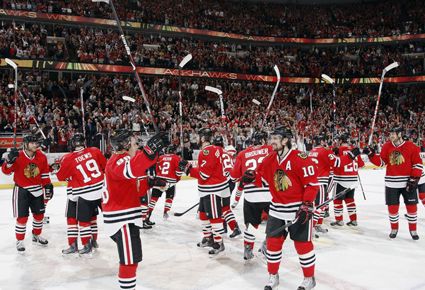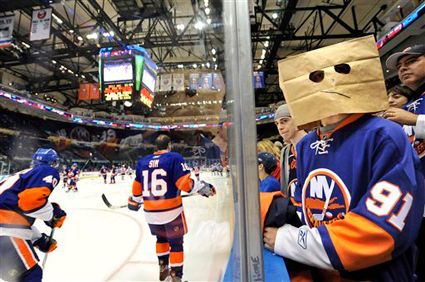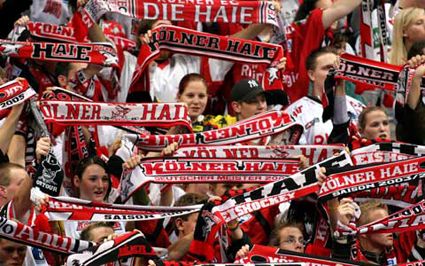Sunday, May 22, 2011
2010-11 Worldwide Hockey Attendance Report
The Chicago Blackhawks were the most watched team on the planet for the third consecutive season in 2010-11, drawing a total of 878,356 fans for an average of 21,423 fans per game which was 108.7% capacity at the United Center.
The Blackhawks salute the world's largest fanbase
Runners up were the Montreal Canadiens at 21,273 which was 100% capacity at the Bell Centre.
Montreal fans are among the most passionate in the NHL
The Philadelphia Flyers were third with 19,715 per game (101.1%), followed by the Detroit Red Wings, who drew 19,680 on average. The Red Wings are the first team on the list to play to less than 100% capacity at 98.1%. They were however, the road attendance leaders, as the NHL's top drawing card were the only team to average over 18,000 for their road games at 18,224, which was 99.8% capacity.
The Toronto Maple Leafs, (19,354/102.9%), Calgary Flames (19,289/100%), St. Louis Blues (19,150/100%) and Vancouver Canucks (18,860/100%) all played to full houses in positions 5 through 8.
St. Louis stood out though as being a particularly weak draw on the road, playing to the lowest average number of fans as the visiting team at 16,229, which was 88.7% of capacity and one of only two teams under 90%.
Vancouver's fans are unlike any other
The Buffalo Sabres (18,452/98.7%) and Washington Capitals (18,397/100%) rounded out the top ten, while the Ottawa Senators 18,378/99.3%) and Pittsburgh Penguins (18,240/100%) came next, with Pittsburgh aided by their move into the new CONSOL Energy Center as well as hosting the 2011 Winter Classic, which drew 68,111 to Heinz Field.
The New York Rangers (18,108/99.5%), Los Angeles Kings (18,083/97.7%) and Minnesota Wild, playing at less than 100% capacity for the first time in their history (18,012/99.7%) came next in spots 13 through 15.
The Boston Bruins (17,565/100%) and San Jose Sharks (17,562/100%) both played to full houses at 16th and 17th.
The Tampa Bay Lightning were the first of the teams to play to less than 90% capacity in the 19,758 seat St. Pete Times Forum, drawing an average of 17,268, which was just 87.4% capacity.
The last of the NHL teams to play to 100% capacity are the Edmonton Oilers, whose overall attendance was limited by the size of the 36-year-old Rexall Place, which seats just 16,839.
Of the six Canadian NHL franchises, Toronto leads at 102.9% capacity, followed by Vancouver at 100.3%, Calgary, Edmonton and Montreal all at 100% and Ottawa at 99.3%, showing that the passion and interest in the game in Canada is alive and well, making a good case for the relocation of the Atlanta Thrashers to Winnipeg, as reported this week by the Toronto Globe and Mail.
The Carolina Hurricanes (16,415) played to 87.6% capacity, followed by the Nashville Predators at 16,142. While 273 fans less than Carolina, their percentage was notably higher at 94.3%.
The first overseas club makes the list at #22, as traditional European attendance leaders SC Bern easily lead all non-NHL teams with an average of 15,856 (92.6%). Not only do they lead all of Europe in numbers, they are also a well organized and intimidating presence unlike anything seen in North American rinks.
Back to the NHL, the Florida Panthers (15,685/81.5%), Dallas Stars (15,073/81.3%), Colorado Avalanche (14,820/82.3%), New Jersey Devils (14,775/83.8%) and Anaheim Ducks (14,738/85.8%) follow in positions 23 - 27.
Four NHL clubs were beaten by German DEL leaders Eisbaren Berlin (Berlin Polar Bears) at 13,946 (98.2%), another European club whose supporters who put the "fan" in fanatic.
The four clubs with serious attendance issues in the NHL begin with the Columbus Blue Jackets at 13,658/75.3% and the threatened Atlanta Thrashers, whose single, winless playoff appearance in 11 seasons has resulted in an average which has dropped to 13,469/72.6%.
Next is a shocker at #31, the University of Wisconsin Badgers of the WCHA conference of the NCAA, at an average of 13,226 partying, red-clad faithful, outdrawing every professional club in the world outside of the NHL save two, as well as two members of the NHL itself!
Following next on the list is an anomaly in the form of the University of Michigan Wolverines at 12,291, boosted by the record setting Big Chill at the Big House outdoor game which drew a confirmed 104,073.
The troubled Phoenix Coyotes ranked 29th in the NHL and 33rd in the world with 12,188 fans for 71.2%. Also beating an NHL club is the University of North Dakota Fighting Sioux, also of the WCHA at 11,756.
Brining up the rear of the NHL is the New York Islanders, hurt by several factors from their aging Nassau Coliseum, intense fan dissatisfaction with their ownership, their overall poor play since 1994, having missed the playoffs 12 times in the last 16 seasons and not having won a playoff series since 1993 when Al Arbour was still coach, and their unprofessional and unacceptable media situation, as their "flagship" radio station is WRHU, a college station at Hofstra University, which employs various broadcast students as color commentators and sideline reporters! The Islanders trail the pack in the NHL in both average numbers and percentage of capacity figures, with attendance down to 11,059, which is a mere 67.9% of capacity, over 1,000 fans per game less than Phoenix and the only NHL club whose capacity is under 70%.
Some of the Islanders fans who do show up want to keep their presence a secret
Trailing just behind are the Quebec Remparts of the Quebec Major Junior Hockey League at 10,929 to lead all of Canadian junior hockey by a wide margin, 1,980 more than the next closest junior club.
The next ranked team worldwide is the surprising Dynamo Minsk of Belarus, whose brand new arena resulted in an average of 10,538 (70.25%) to lead the predominately Russian KHL, moving them up the European rankings from 61st to 3rd!
The 38th ranked team in the world are the Hershey Bears of the American Hockey League, averaging 9,800 fans per game. After the two German clubs Kolner Haie (Cologne Sharks) at 9,696 and Adler Mannheim (Manheim Eagles) at 9,689, the 41st ranked team is the University of Minnesota Golden Gophers, again of the WCHA, who at 9,544 are down somewhat from their usual 10,000.
Cologne Sharks fans show their support with soccer-style scarves
The Swedish attendance leaders come in at #42 in the form of the Frolunda Indians at 9,378.
Two more KHL clubs, Avanagard Omsk (9,303) and Lokomotiv Yaroslavl (8,998) edge out the London Knights, leaders of the Ontario Hockey League at 8,948. The top Czech and Finnish clubs, HC Pardubice (8,922) and Jokerit Helsinki (8,490) are up next at #46 and #47. The Manitoba Moose of the AHL check in with 8,404 followed by the Western Hockey League leaders, the Calgary Hitmen at 8,263 and SKA St. Petersburg of Russia averages 8,170 to round out the Top 50.
Also of note are #55 Medvescak Zagreb of Croatia, who compete in the top Austrian league at 7,837 and the #58 Chicago Wolves of the AHL at 7,453, an impressive number playing in the top drawing Blackhawks backyard, making Chicago the world leader in hockey attendance over Calgary's Flames and Hitmen, and #59, the Fort Wayne Komets, who lead the Central Hockey League by far with 7,451.
League-wise, the NHL leads with an average of 16,956, followed by the surprising Western Collegiate Hockey Association at 6,730, outdrawing on average every other professional league in the world! The Swiss National League A (6,306) is third overall and the best attended league in Europe followed by Sweden's Elitserien (6,160), Russia's Kontinental Hockey League (5,785), Germany's DEL (5,756), the North American minor league AHL (5,380), the Czech Extraliga (4,936) and the NCAA's Hockey East (4,934), while Finland's SM-liiga rounds out the Top 10 with 4,833.
While the NHL rules the world, one would expect the Russian KHL to have to rank higher up the list, certainly above leagues in Switzerland and Germany and most assuredly higher than a United States collegiate league, to be able to dole out some of the contracts they have lavished on players since the league's formation.
Labels:
Worldwide Attendance Report
Subscribe to:
Post Comments (Atom)

















No comments:
Post a Comment
We welcome and encourage genuine comments and corrections from our readers. Please no spam. It will not be approved and never seen.